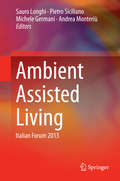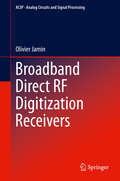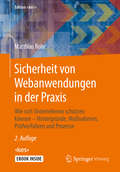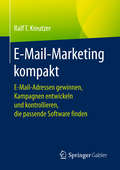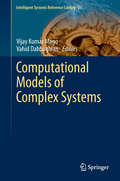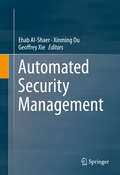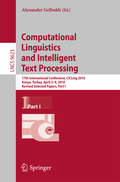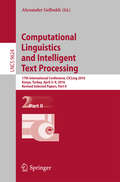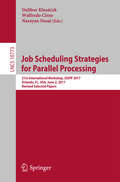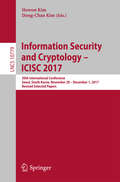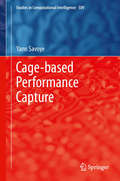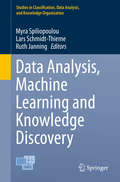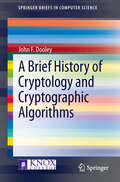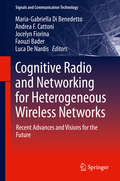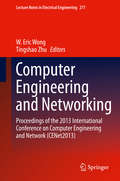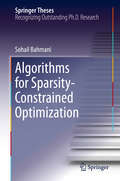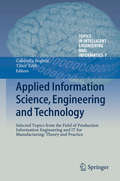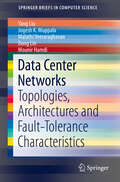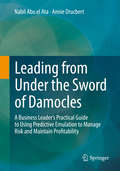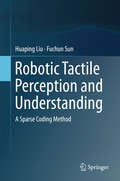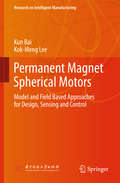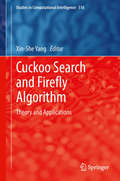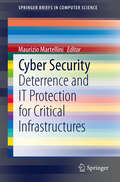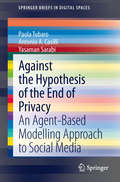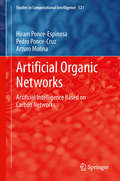- Table View
- List View
Ambient Assisted Living: Italian Forum 2013 (Lecture Notes in Electrical Engineering #11)
by Sauro Longhi Pietro Siciliano Michele Germani Andrea MonteriùThis book presents the refereed proceedings of the Fourth Italian Forum on Ambient Assisted Living (AAL), held in Ancona, Italy, in October 2013. A wide range of issues are covered and new technological developments are described which will support the autonomy and independence of individuals with special needs through an innovative and integrated approach, designed to respond to the socio-economic challenges of an aging population. Topics addressed include: health and well-being, prevention and rehabilitation and support for care providers; active aging and its social implications; services for the frail elderly with health problems and their families; nutrition; ICT platforms/technologies for the benefit of the elderly; home automation and control technologies (autonomy, safety and energy saving); smart cities and smart communities; telemedicine, telerehabilitation, and telecare; mobility, participation and social inclusion; games and fun for the elderly; building design; social housing; interface design and interaction (accessibility, acceptance); social policies to encourage and support active aging; business models, market analysis and development of sustainable financing and business and ethics, privacy and data protection. Many experimental validations based on user trials and usability testing are presented and discussed. The knowledge and insights provided in this book will help researchers and others involved in AAL to understand relevant societal trends, novel technological developments and pressing challenges.
Broadband Direct RF Digitization Receivers (Analog Circuits and Signal Processing #121)
by Olivier JaminThis book discusses the trade-offs involved in designing direct RF digitization receivers for the radio frequency and digital signal processing domains. A system-level framework is developed, quantifying the relevant impairments of the signal processing chain, through a comprehensive system-level analysis. Special focus is given to noise analysis (thermal noise, quantization noise, saturation noise, signal-dependent noise), broadband non-linear distortion analysis, including the impact of the sampling strategy (low-pass, band-pass), analysis of time-interleaved ADC channel mismatches, sampling clock purity and digital channel selection. The system-level framework described is applied to the design of a cable multi-channel RF direct digitization receiver. An optimum RF signal conditioning, and some algorithms (automatic gain control loop, RF front-end amplitude equalization control loop) are used to relax the requirements of a 2.7GHz 11-bit ADC. A two-chip implementation is presented, using BiCMOS and 65nm CMOS processes, together with the block and system-level measurement results. Readers will benefit from the techniques presented, which are highly competitive, both in terms of cost and RF performance, while drastically reducing power consumption.
Sicherheit von Webanwendungen in der Praxis: Wie Sich Unternehmen Schu?tzen Ko?nnen -- Hintergru?nde, Maßnahmen, Pru?fverfahren Und Prozesse (Edition Kes Ser.)
by Matthias RohrWebanwendungen bilden in Unternehmen zahlreiche sensible Geschäftsprozesse ab – ob mit Kunden, mit Mitarbeitern, Partnern und Zulieferern. Daher sind Webapplikationen ein Sicherheitsrisiko für Unternehmen und ihr Schutz von entscheidender Bedeutung. In dem Buch beleuchtet der Autor die wichtigsten Aspekte der Webanwendungssicherheit und stützt sich dabei auf seine langjährige Erfahrung als IT-Security-Berater für Webanwendungen und Entwicklungsprozesse.Der Band bietet neben einem allgemeinen Überblick zum Thema Sicherheit von Webanwendungen ausführliche und praxisorientierte Darstellungen zu wichtigen Einzelfragen: Was sind die häufigsten Schwachstellen und mit welchen Maßnahmen lassen sich Webanwendungen am effektivsten gegen Angriffe absichern? Ein eigenes Kapitel befasst sich mit den Verfahren, die eingesetzt werden, um die Sicherheit von Anwendungen bereits im Entwicklungsprozess zu bewerten und zu überprüfen. Der Autor erläutert zudem, wie sich die Sicherheit in selbst entwickelten und zugekauften Webanwendungen durch organisatorische Prozesse nachhaltig verbessern lässt.Die zweite Auflage des 2014 erstmals erschienen Buchs wurde vor dem Hintergrund neuer Techniken zur Abwehr von Angriffen und neuer Prüfverfahren vollständig überarbeitet und aktualisiert. Auch aktuelle Beratungsprojekte des Autors haben Eingang in die Neuauflage gefunden – insbesondere dort, wo es um organisatorische Aspekte von Webanwendungssicherheit geht.Der Band richtet sich an Entwickler von Webanwendungen, IT-Security- und Qualitätsmanager genauso wie an Leser, die sich in das Thema Webanwendungssicherheit einarbeiten wollen.
E-Mail-Marketing kompakt: E-mail-adressen Gewinnen, Kampagnen Entwickeln Und Kontrollieren, Die Passende Software Finden
by Ralf T. KreutzerDieses Buch zeigt, dass E-Mail-Marketing für die Unternehmenskommunikation unverzichtbar ist und bleibt. Es gibt über fünf Milliarden E-Mail-Accounts, aber "nur" zwei Milliarden Facebook-Nutzer! Schon allein durch diese Zahlen wird die Relevanz des E-Mail-Marketings deutlich. Durch E-Mail-Marketing kann und darf unmittelbar verkauft werden. Und Erfolge lassen sich leicht feststellen. Aber wie sollte das E-Mail-Marketing heute ausgestaltet werden? Welche Erfolgsfaktoren sind zu berücksichtigen? Wie sind E-Mails und E-Newsletter zu gestalten, um eine möglichst hohe Wirkung zu entfalten? Und anhand welcher KPIs kann der Erfolg gemessen werden? In diesem Werk werden alle zentralen Fragen zum E-Mail-Marketing kompetent beantwortet.
Computational Models of Complex Systems (Intelligent Systems Reference Library #53)
by Vahid Dabbaghian Vijay Kumar MagoComputational and mathematical models provide us with the opportunities to investigate the complexities of real world problems. They allow us to apply our best analytical methods to define problems in a clearly mathematical manner and exhaustively test our solutions before committing expensive resources. This is made possible by assuming parameter(s) in a bounded environment, allowing for controllable experimentation, not always possible in live scenarios. For example, simulation of computational models allows the testing of theories in a manner that is both fundamentally deductive and experimental in nature. The main ingredients for such research ideas come from multiple disciplines and the importance of interdisciplinary research is well recognized by the scientific community. This book provides a window to the novel endeavours of the research communities to present their works by highlighting the value of computational modelling as a research tool when investigating complex systems. We hope that the readers will have stimulating experiences to pursue research in these directions.
Automated Security Management
by Ehab Al-Shaer Xinming Ou Geoffrey XieIn this contributed volume, leading international researchers explore configuration modeling and checking, vulnerability and risk assessment, configuration analysis, and diagnostics and discovery. The authors equip readers to understand automated security management systems and techniques that increase overall network assurability and usability. These constantly changing networks defend against cyber attacks by integrating hundreds of security devices such as firewalls, IPSec gateways, IDS/IPS, authentication servers, authorization/RBAC servers, and crypto systems. Automated Security Management presents a number of topics in the area of configuration automation. Early in the book, the chapter authors introduce modeling and validation of configurations based on high-level requirements and discuss how to manage the security risk as a result of configuration settings of network systems. Later chapters delve into the concept of configuration analysis and why it is important in ensuring the security and functionality of a properly configured system. The book concludes with ways to identify problems when things go wrong and more. A wide range of theoretical and practical content make this volume valuable for researchers and professionals who work with network systems.
Computational Linguistics and Intelligent Text Processing: 16th International Conference, Cicling 2015, Cairo, Egypt, April 14-20, 2015, Proceedings, Part I (Lecture Notes in Computer Science #9041)
by Alexander GelbukhThe two-volume set LNCS 9623 + 9624 constitutes revised selected papers from the CICLing 2016 conference which took place in Konya, Turkey, in April 2016. The total of 89 papers presented in the two volumes was carefully reviewed and selected from 298 submissions. The book also contains 4 invited papers and a memorial paper on Adam Kilgarriff’s Legacy to Computational Linguistics. The papers are organized in the following topical sections: Part I: In memoriam of Adam Kilgarriff; general formalisms; embeddings, language modeling, and sequence labeling; lexical resources and terminology extraction; morphology and part-of-speech tagging; syntax and chunking; named entity recognition; word sense disambiguation and anaphora resolution; semantics, discourse, and dialog. Part II: machine translation and multilingualism; sentiment analysis, opinion mining, subjectivity, and social media; text classification and categorization; information extraction; and applications.
Computational Linguistics and Intelligent Text Processing: 16th International Conference, Cicling 2015, Cairo, Egypt, April 14-20, 2015, Proceedings, Part I (Lecture Notes in Computer Science #9041)
by Alexander GelbukhThe two-volume set LNCS 9623 + 9624 constitutes revised selected papers from the CICLing 2016 conference which took place in Konya, Turkey, in April 2016. The total of 89 papers presented in the two volumes was carefully reviewed and selected from 298 submissions. The book also contains 4 invited papers and a memorial paper on Adam Kilgarriff’s Legacy to Computational Linguistics. The papers are organized in the following topical sections: Part I: In memoriam of Adam Kilgarriff; general formalisms; embeddings, language modeling, and sequence labeling; lexical resources and terminology extraction; morphology and part-of-speech tagging; syntax and chunking; named entity recognition; word sense disambiguation and anaphora resolution; semantics, discourse, and dialog. Part II: machine translation and multilingualism; sentiment analysis, opinion mining, subjectivity, and social media; text classification and categorization; information extraction; and applications.
Job Scheduling Strategies for Parallel Processing: 18th International Workshop, Jsspp 2014, Phoenix, Az, Usa, May 23, 2014. Revised Selected Papers (Lecture Notes in Computer Science #8828)
by Dalibor Klusáček Walfredo Cirne Narayan DesaiThis book constitutes the thoroughly refereed post-conference proceedings of the 21st International Workshop on Job Scheduling Strategies for Parallel Processing, JSSPP 2017, held in Orlando, FL, USA, in June 2017.The 10 revised full papers presented in this book were carefully reviewed and selected from 20 submissions. The papers cover topics in the fields of design and evaluation of new scheduling approaches; performance evaluation of scheduling approaches; workloads; consideration of additional constraints in scheduling systems; scaling and composition of very large scheduling systems; cloud provider issues; interaction between schedulers on different levels; interaction between applications/workloads; experience reports from production systems or large scale compute campaigns.
Information Security and Cryptology – ICISC 2017: 20th International Conference, Seoul, South Korea, November 29 - December 1, 2017, Revised Selected Papers (Lecture Notes in Computer Science #10779)
by Howon Kim Dong-Chan KimThis book constitutes revised selected papers from the 20th International Conference on Information Security and Cryptology, ICISC 2017, held in Seoul, South Korea, in November/December 2017. The total of 20 papers presented in this volume were carefully reviewed and selected from 70 submissions. The papers were organized in topical sections named: symmetric key encryption; homomorphic encryption, side channel analysis and implementation; broadcast encryption; elliptic curve; signature and protocol; and network and system security.
Cage-based Performance Capture (Studies in Computational Intelligence #509)
by Yann SavoyeNowadays, highly-detailed animations of live-actor performances are increasingly easier to acquire and 3D Video has reached considerable attentions in visual media production. In this book, we address the problem of extracting or acquiring and then reusing non-rigid parametrization for video-based animations. At first sight, a crucial challenge is to reproduce plausible boneless deformations while preserving global and local captured properties of dynamic surfaces with a limited number of controllable, flexible and reusable parameters. To solve this challenge, we directly rely on a skin-detached dimension reduction thanks to the well-known cage-based paradigm. First, we achieve Scalable Inverse Cage-based Modeling by transposing the inverse kinematics paradigm on surfaces. Thus, we introduce a cage inversion process with user-specified screen-space constraints. Secondly, we convert non-rigid animated surfaces into a sequence of optimal cage parameters via Cage-based Animation Conversion. Building upon this reskinning procedure, we also develop a well-formed Animation Cartoonization algorithm for multi-view data in term of cage-based surface exaggeration and video-based appearance stylization. Thirdly, motivated by the relaxation of prior knowledge on the data, we propose a promising unsupervised approach to perform Iterative Cage-based Geometric Registration. This novel registration scheme deals with reconstructed target point clouds obtained from multi-view video recording, in conjunction with a static and wrinkled template mesh. Above all, we demonstrate the strength of cage-based subspaces in order to reparametrize highly non-rigid dynamic surfaces, without the need of secondary deformations. To the best of our knowledge this book opens the field of Cage-based Performance Capture.
Data Analysis, Machine Learning and Knowledge Discovery (Studies in Classification, Data Analysis, and Knowledge Organization)
by Myra Spiliopoulou Lars Schmidt-Thieme Ruth JanningData analysis, machine learning and knowledge discovery are research areas at the intersection of computer science, artificial intelligence, mathematics and statistics. They cover general methods and techniques that can be applied to a vast set of applications such as web and text mining, marketing, medicine, bioinformatics and business intelligence. This volume contains the revised versions of selected papers in the field of data analysis, machine learning and knowledge discovery presented during the 36th annual conference of the German Classification Society (GfKl). The conference was held at the University of Hildesheim (Germany) in August 2012.
A Brief History of Cryptology and Cryptographic Algorithms (SpringerBriefs in Computer Science)
by John F. DooleyThe science of cryptology is made up of two halves. Cryptography is the study of how to create secure systems for communications. Cryptanalysis is the study of how to break those systems. The conflict between these two halves of cryptology is the story of secret writing. For over 2,000 years, the desire to communicate securely and secretly has resulted in the creation of numerous and increasingly complicated systems to protect one's messages. Yet for every system there is a cryptanalyst creating a new technique to break that system. With the advent of computers the cryptographer seems to finally have the upper hand. New mathematically based cryptographic algorithms that use computers for encryption and decryption are so secure that brute-force techniques seem to be the only way to break them - so far. This work traces the history of the conflict between cryptographer and cryptanalyst, explores in some depth the algorithms created to protect messages, and suggests where the field is going in the future.
Cognitive Radio and Networking for Heterogeneous Wireless Networks: Recent Advances and Visions for the Future (Signals and Communication Technology)
by Maria-Gabriella Di Benedetto Faouzi Bader Andrea F. Cattoni Jocelyn Fiorina Luca De NardisThis book, written by leading experts from academia and industry, offers a condensed overview on hot topics among the Cognitive Radios and Networks scientific and industrial communities (including those considered within the framework of the European COST Action IC0902) and presents exciting visions for the future. Examples of the subjects considered include the design of new filter bank-based air interfaces for spectrum sharing, medium access control design protocols, the design of cloud-based radio access networks, an evolutionary vision for the development and deployment of cognitive TCP/IP, and regulations relevant to the development of a spectrum sharing market. The concluding chapter comprises a practical, hands-on tutorial for those interested in developing their own research test beds. By focusing on the most recent advances and future avenues, this book will assist researchers in understanding the current issues and solutions in Cognitive Radios and Networks designs.
Computer Engineering and Networking: Proceedings of the 2013 International Conference on Computer Engineering and Network (CENet2013) (Lecture Notes in Electrical Engineering #10152)
by W. Eric Wong Tingshao ZhuThis book aims to examine innovation in the fields of computer engineering and networking. The book covers important emerging topics in computer engineering and networking, and it will help researchers and engineers improve their knowledge of state-of-art in related areas. The book presents papers from The Proceedings of the 2013 International Conference on Computer Engineering and Network (CENet2013) which was held on 20-21 July, in Shanghai, China.
Algorithms for Sparsity-Constrained Optimization (Springer Theses #261)
by Sohail BahmaniThis thesis demonstrates techniques that provide faster and more accurate solutions to a variety of problems in machine learning and signal processing. The author proposes a "greedy" algorithm, deriving sparse solutions with guarantees of optimality. The use of this algorithm removes many of the inaccuracies that occurred with the use of previous models.
Applied Information Science, Engineering and Technology: Selected Topics from the Field of Production Information Engineering and IT for Manufacturing: Theory and Practice (Topics in Intelligent Engineering and Informatics #7)
by Gabriella Bognár Tibor TóthThe objective of the book is to give a selection from the papers, which summarize several important results obtained within the framework of the József Hatvany Doctoral School operating at the University of Miskolc, Hungary. In accordance with the three main research areas of the Doctoral School established for Information Science, Engineering and Technology, the papers can be classified into three groups. They are as follows: (1) Applied Computational Science; (2) Production Information Engineering (IT for Manufacturing included); (3) Material Stream Systems and IT for Logistics. As regards the first area, some papers deal with special issues of algorithms theory and its applications, with computing algorithms for engineering tasks, as well as certain issues of data base systems and knowledge intensive systems. Related to the second research area, the focus is on Production Information Engineering with special regard to discrete production processes. In the second research area the papers show some new integrated systems suitable for optimizing discrete production processes in a top-down way. The papers connecting with the third research field deal with different issues of materials stream systems and logistics, taking into consideration of applied mathematical models and IT-tools. The book makes an effort to ensure certain equilibrium between theory and practice and to show some new approach both from theoretical modelling aspect, as well as experimental and practical point of view.
Data Center Networks: Topologies, Architectures and Fault-Tolerance Characteristics (SpringerBriefs in Computer Science)
by Yang Liu Jogesh K. Muppala Malathi Veeraraghavan Dong Lin Mounir HamdiThis SpringerBrief presents a survey of data center network designs and topologies and compares several properties in order to highlight their advantages and disadvantages. The brief also explores several routing protocols designed for these topologies and compares the basic algorithms to establish connections, the techniques used to gain better performance, and the mechanisms for fault-tolerance. Readers will be equipped to understand how current research on data center networks enables the design of future architectures that can improve performance and dependability of data centers. This concise brief is designed for researchers and practitioners working on data center networks, comparative topologies, fault tolerance routing, and data center management systems. The context provided and information on future directions will also prove valuable for students interested in these topics.
Leading from Under the Sword of Damocles: A Business Leader's Practical Guide To Using Predictive Emulation To Manage Risk And Maintain Profitability
by Nabil Abu el Ata Annie DrucbertGlobalization trends and the rapid pace of technological innovations have introduced unprecedented change and uncertainty. For unprepared businesses, the drivers of the Fourth Industrial Revolution will become a constant source of surprise and crises will unfold at an ever-increasing rate. To thrive under these conditions, companies must adopt new risk management technologies and practices that enable business leaders to better anticipate and adjust to changing dynamics.This book helps readers understand how algorithm-based predictive and prescriptive analytics principles can be used to control risk in today’s dynamic business environment. It serves as a reference guide for business leaders and risk management practitioners of companies that are global in reach or operate dynamically complex systems. Using the technological and scientific innovations presented in this book, business leaders can gain a wider understanding of risk and prescriptively determine which actions are necessary to ensure the business is optimally positioned to meet its stated long-term goals and objectives.Case studies show how the presented methods can be practically applied to preemptively expose risks and support decisions to optimize, transform or disrupt current business models, strategies, organizational structure and information systems when necessary to maintain a market position or outperform competitors.These methods have been proven through hundreds of client cases. By using mathematical emulation to link business risks to strategic imperatives, it becomes possible to achieve a higher annual profit margin and better growth. As we enter the Fourth Industrial Revolution, companies that are able to expose risks caused by dynamic complexity and maintain the alignment between the goals of the business and operational execution will be better prepared to make the shifts necessary for long-term success and keep the business moving toward its goals.
Robotic Tactile Perception and Understanding: A Sparse Coding Method
by Huaping Liu Fuchun SunThis book introduces the challenges of robotic tactile perception and task understanding, and describes an advanced approach based on machine learning and sparse coding techniques. Further, a set of structured sparse coding models is developed to address the issues of dynamic tactile sensing. The book then proves that the proposed framework is effective in solving the problems of multi-finger tactile object recognition, multi-label tactile adjective recognition and multi-category material analysis, which are all challenging practical problems in the fields of robotics and automation. The proposed sparse coding model can be used to tackle the challenging visual-tactile fusion recognition problem, and the book develops a series of efficient optimization algorithms to implement the model. It is suitable as a reference book for graduate students with a basic knowledge of machine learning as well as professional researchers interested in robotic tactile perception and understanding, and machine learning.
Permanent Magnet Spherical Motors: Model And Field Based Approaches For Design, Sensing And Control (Research on Intelligent Manufacturing)
by Kun Bai Kok-Meng LeeThis book introduces and illustrates modeling, sensing, and control methods for analyzing, designing, and developing spherical motors. It systematically presents models for establishing the relationships among the magnetic fields, position/orientation and force/torque, while also providing time-efficient solutions to assist researchers and engineers in studying and developing these motors. In order to take full advantage of spherical motors’ compact structure in practical applications, sensing and control methods that utilize their magnetic fields and eliminate the need to install external sensors for feedback are proposed. Further, the book investigates for the first time spherical motors’ force/torque manipulation capability, and proposes algorithms enabling the ball-joint-like end-effector for haptic use based on these motors’ hybrid position/force actuation modes. While systematically presenting approaches to their design, sensing and control, the book also provides many examples illustrating the implementation issues readers may encounter.
Cuckoo Search and Firefly Algorithm: Theory and Applications (Studies in Computational Intelligence #516)
by Xin-She YangNature-inspired algorithms such as cuckoo search and firefly algorithm have become popular and widely used in recent years in many applications. These algorithms are flexible, efficient and easy to implement. New progress has been made in the last few years, and it is timely to summarize the latest developments of cuckoo search and firefly algorithm and their diverse applications. This book will review both theoretical studies and applications with detailed algorithm analysis, implementation and case studies so that readers can benefit most from this book. Application topics are contributed by many leading experts in the field. Topics include cuckoo search, firefly algorithm, algorithm analysis, feature selection, image processing, travelling salesman problem, neural network, GPU optimization, scheduling, queuing, multi-objective manufacturing optimization, semantic web service, shape optimization, and others. This book can serve as an ideal reference for both graduates and researchers in computer science, evolutionary computing, machine learning, computational intelligence, and optimization, as well as engineers in business intelligence, knowledge management and information technology.
Cyber Security: Deterrence and IT Protection for Critical Infrastructures (SpringerBriefs in Computer Science)
by Maurizio MartelliniThe experts of the International Working Group-Landau Network Centro Volta (IWG-LNCV) discuss aspects of cyber security and present possible methods of deterrence, defense and resilience against cyber attacks. This SpringerBrief covers state-of-the-art documentation on the deterrence power of cyber attacks and argues that nations are entering a new cyber arms race. The brief also provides a technical analysis of possible cyber attacks towards critical infrastructures in the chemical industry and chemical safety industry. The authors also propose modern analyses and a holistic approach to resilience and security of Industrial Control Systems. The combination of contextual overview and future directions in the field makes this brief a useful resource for researchers and professionals studying systems security, data security and data structures. Advanced-level students interested in data security will also find this brief a helpful guide to recent research.
Against the Hypothesis of the End of Privacy: An Agent-Based Modelling Approach to Social Media (SpringerBriefs in Digital Spaces)
by Paola Tubaro Antonio A Casilli Yasaman SarabiSeveral prominent public voices have advanced the hypothesis that networked communications erode the value of privacy in favor of a transparent connected existence. Especially younger generations are often described as prone to live "open digital lives". This hypothesis has raised considerable controversy, polarizing the reaction of its critics as well as of its partisans. But how likely is the "end of privacy"? Under which conditions might this scenario come to be? What are the business and policy implications? How to ethically assess risks and opportunities? To shed light on the co-evolution and mutual dependencies of networked structures and individual and collective strategies towards privacy, this book innovatively uses cutting-edge methods in computational social sciences to study the formation and maintenance of online social networks. The findings confound common arguments and clearly indicate that Internet and social media do not necessarily entail the end of privacy. Publicity is not "the new norm": quite to the contrary, the book makes the case that privacy is a resilient social force, resulting from a set of interconnected behaviors of Internet users.
Artificial Organic Networks: Artificial Intelligence Based on Carbon Networks (Studies in Computational Intelligence #521)
by Hiram Ponce-Espinosa Pedro Ponce-Cruz Arturo MolinaThis monograph describes the synthesis and use of biologically-inspired artificial hydrocarbon networks (AHNs) for approximation models associated with machine learning and a novel computational algorithm with which to exploit them. The reader is first introduced to various kinds of algorithms designed to deal with approximation problems and then, via some conventional ideas of organic chemistry, to the creation and characterization of artificial organic networks and AHNs in particular. The advantages of using organic networks are discussed with the rules to be followed to adapt the network to its objectives. Graph theory is used as the basis of the necessary formalism. Simulated and experimental examples of the use of fuzzy logic and genetic algorithms with organic neural networks are presented and a number of modeling problems suitable for treatment by AHNs are described: · approximation; · inference; · clustering; · control; · classification; and · audio-signal filtering. The text finishes with a consideration of directions in which AHNs could be implemented and developed in future. A complete LabVIEW(tm) toolkit, downloadable from the book's page at springer. com enables readers to design and implement organic neural networks of their own. The novel approach to creating networks suitable for machine learning systems demonstrated in Artificial Organic Networks will be of interest to academic researchers and graduate students working in areas associated with computational intelligence, intelligent control, systems approximation and complex networks.
